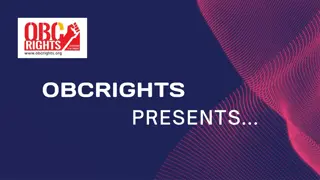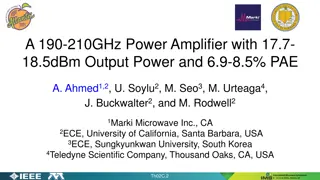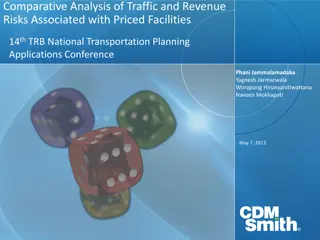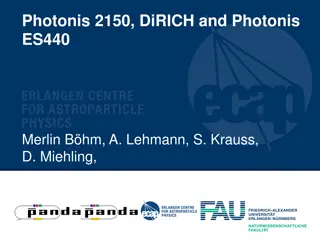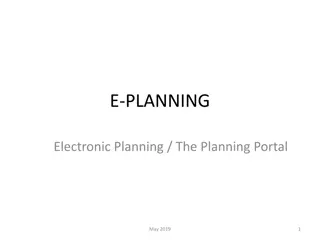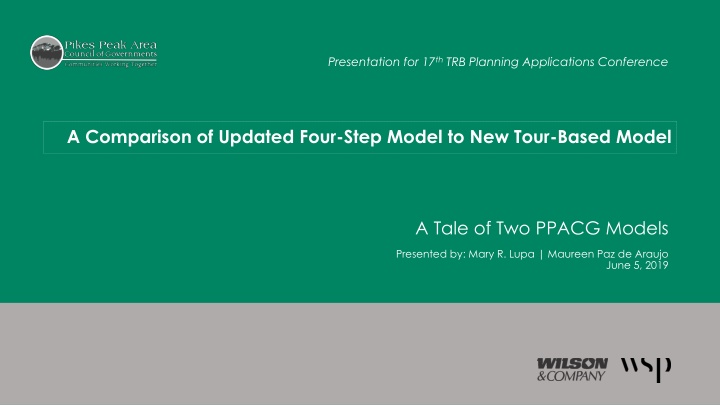
Comparison of Updated Four-Step Model to New Tour-Based Model
Explore the transition from a legacy Four-Step model to a modern Tour-Based model in the context of transportation planning applications. Discover the shortcomings of the existing model and the benefits of adopting a new approach, all presented in a captivating tale of two models.
Download Presentation

Please find below an Image/Link to download the presentation.
The content on the website is provided AS IS for your information and personal use only. It may not be sold, licensed, or shared on other websites without obtaining consent from the author. If you encounter any issues during the download, it is possible that the publisher has removed the file from their server.
You are allowed to download the files provided on this website for personal or commercial use, subject to the condition that they are used lawfully. All files are the property of their respective owners.
The content on the website is provided AS IS for your information and personal use only. It may not be sold, licensed, or shared on other websites without obtaining consent from the author.
E N D
Presentation Transcript
Presentation for 17thTRB Planning Applications Conference A Comparison of Updated Four-Step Model to New Tour-Based Model A Tale of Two PPACG Models Presented by: Mary R. Lupa | Maureen Paz de Araujo June 5, 2019
Outline What did we do? Why did we do it? Why not go for broke (full ABM) What structure was used? Performance of the 2 models (daily traffic) Time and dollar cost Next steps A TALE OF TWO MODELS: COMPARISON OF PPACG LEGACY TRIPS-BASED MODEL & NEW TOUR-BASED MODEL
2016 Modeling Suite Updates TRAVEL DEMAND FORECASTS (PTV VISUM / VISEM) Four-Step Travel Model (Updated to 2015 Base Year) PTV Tour-Based Travel Model (2015 Base Year) SYNTHETIC POPULATION GENERATION PopGen2 SOCIOECONOMIC FORECASTS Cloud-Based UrbanSim A TALE OF TWO MODELS: COMPARISON OF PPACG LEGACY TRIPS-BASED MODEL & NEW TOUR-BASED MODEL
Tour-Based Model WHY A TOUR-BASED MODEL? PPACG s Four-Step Model lacks detail and fidelity to support planning roles and responsibilities. The current trips-based model: Does not account for trip interdependencies models only discrete one-way trips Lacks detail needed to evaluate travel behavior of individuals individuals within households are modeled as groups with homogeneous travel behavior Is relatively insensitive to time-of-day only eight time-of-day slices are modeled Understates the role of accessibility doesn t capture travel decisions made based on accessibility A TALE OF TWO MODELS: COMPARISON OF PPACG LEGACY TRIPS-BASED MODEL & NEW TOUR-BASED MODEL
Tour-Based Model WHY NOT A FULL ACTIVITY-BASED MODEL? Migration to a full ABM was not a good fit for PPACG in the near term primarily due to resource constraints. Factors weighing against near-term implementation of a full ABM included: Initial Development Cost typical model costs $1M to $1.4M Technical Issues run times, greater data requirements, inconsistency of outputs, model accessibility for external users Staffing and Training modeling staff of one, potential for staff turn-over, staff knowledge base Institutional Issues potential sensitivity to changing the status quo A TALE OF TWO MODELS: COMPARISON OF PPACG LEGACY TRIPS-BASED MODEL & NEW TOUR-BASED MODEL
Tour-Based Model IF NOT AN ABM, WHAT THEN? Atour-based model offered PPACG a right-sized , incremental step toward ABM functionality. Cost effective development of the new model was accomplished by: Leveraging resources funding and agency staff resources Using a blended team to staff and expedite model development, while building agency staff capability/knowledge base Preserving model compatibility/continuity networks and zonal data were updated concurrently for the two models Developing comprehensive documentation technical methodology report, training materials, and user guide A TALE OF TWO MODELS: COMPARISON OF PPACG LEGACY TRIPS-BASED MODEL & NEW TOUR-BASED MODEL
Model Development Approach FOLLOWING A DIFFERENT PATH Rather than upfront development or transfer and refine implementation, PPACG chose to use an adapted incremental implementation approach: First step in path to a full ABM Built on current trips-based model structure and software platform to facilitate transition to new model. Developed in parallel the trips-based model was maintained as the official model to support transition and external users. Both models used the 2010 Front Range CO household travel survey. A TALE OF TWO MODELS: COMPARISON OF PPACG LEGACY TRIPS-BASED MODEL & NEW TOUR-BASED MODEL
Tour-Based Model Structure TOUR-BASED MODEL: Retains current software implements a tour-based add-on module (VISEM); only synthetic population generation (PopGen2) is an external data/process. A combination of python scripts and built-in procedures are used, all within VISUM. Focuses on essential upgrade addition of tour generation model. Retains some trips-based model components distribution parameters, mode choice coefficients, transit skimming and assignment, truck model and trip assignment were adapted and retained. Uses matrix operations to convert retained components to tour-based format. A TALE OF TWO MODELS: COMPARISON OF PPACG LEGACY TRIPS-BASED MODEL & NEW TOUR-BASED MODEL
TOUR-BASED MODEL OVERVIEW OF METHODOLOGY Disaggregate simulation-based tour generation is combined with aggregate tour-based destination and mode choice Disaggregate person level tour frequency choice Synthetic Population (PopGen2) Number of work-based sub-tours constrained to work destinations Tour type / stop frequency choice at zone level by person type Aggregate destination/mode choice by person/tour type Work based sub-tour using work destination as control total TOUR-BASED MODEL- SYNTHETIC POPULATION- LEGACY TRIPS-BASED MODEL
Tour-Based Model Components Person Types 8 types: Non-worker, senior, 3 students levels 3 worker income levels. Activity Codes 5 codes: home, other, school, work and stop (end). Activities are classified as home or non-home. Tour types 29 skeletal tour type combinations. Time periods 24 one-hour periods Verification of trip tour rates done against Columbus OH and Phoenix AZ A TALE OF TWO MODELS: COMPARISON OF PPACG LEGACY TRIPS-BASED MODEL & NEW TOUR-BASED MODEL
Four-Step Model Validation 2015 Validation: R2=0.93 %RMSE=31 A TALE OF TWO MODELS: COMPARISON OF PPACG LEGACY TRIPS-BASED MODEL & NEW TOUR-BASED MODEL
Tour-Based Model Model Validation 2015 Validation: R2=0.9; %RMSE=25 A TALE OF TWO MODELS: COMPARISON OF PPACG LEGACY TRIPS-BASED MODEL & NEW TOUR-BASED MODEL
Tour-Based Model Facts & Dimensions HOW THE TOUR-BASED MODEL MEASURES UP Hardware Standard laptop computer (workstation specifications desirable) Software PTV VISUM with tour-based add-on module Run time shorter than trips-based model, < 3 hours VISUM version (scenario) size on disk < 1GB Development timeframe beta version three months Development cost $210K A TALE OF TWO MODELS: COMPARISON OF PPACG LEGACY TRIPS-BASED MODEL & NEW TOUR-BASED MODEL
Next Steps PPACG has set the tour-based model as their official model! Continue collaborative model development & application Improve truck models A TALE OF TWO MODELS: COMPARISON OF PPACG LEGACY TRIPS-BASED MODEL & NEW TOUR-BASED MODEL
Questions? A TALE OF TWO MODELS: COMPARISON OF PPACG LEGACY TRIPS-BASED MODEL & NEW TOUR-BASED MODEL

